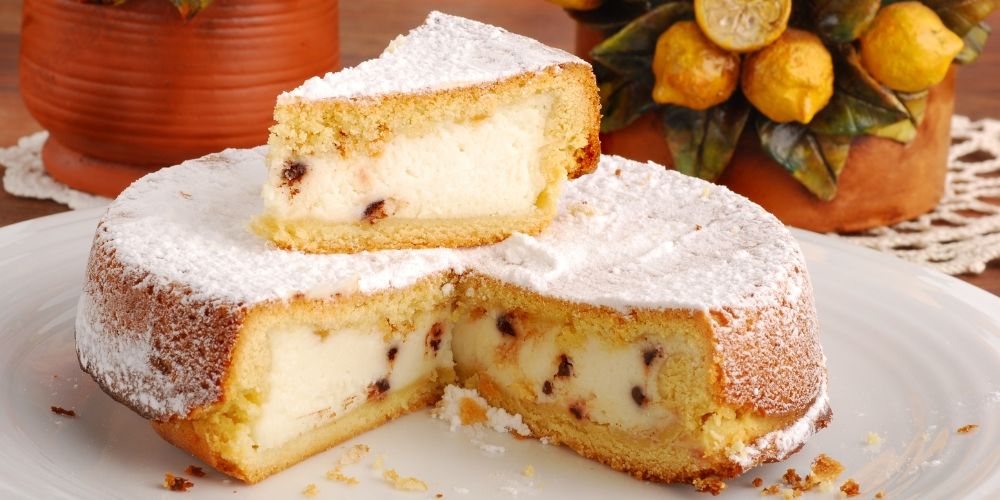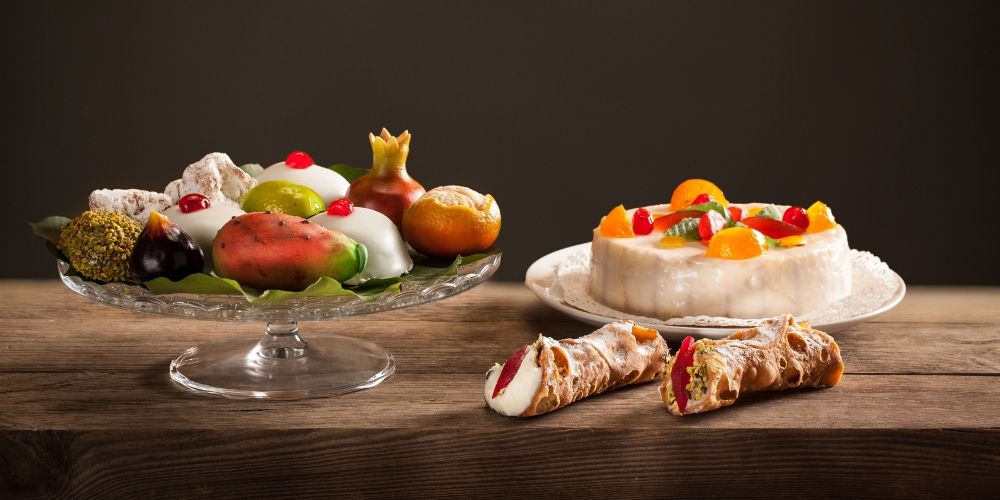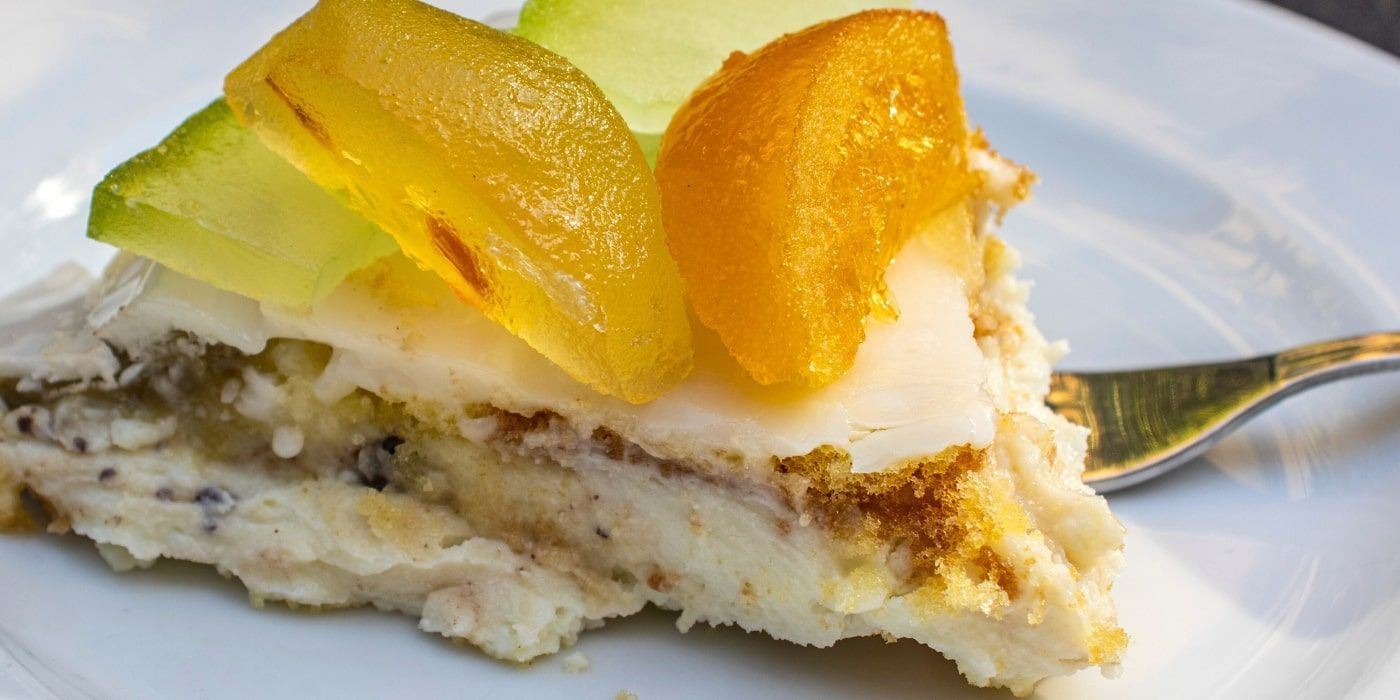“Tintu è cu nun mancia a cassata a matina ri Pasqua” ("Poor man who doesn't eat cassata on Easter morning.")
The history of Sicilian cassata is the story of the many dominations that have taken place on the island in the heart of the Mediterranean.
It is the quintessential Sicilian pastry dessert: a sponge cake filled with sweetened ricotta cream, candied fruit and chocolate chips, covered with a layer of green martorana paste and decorated with sugar icing and large pieces of candied fruit.
It is an elaborate and mouth-watering dessert whose final recipe took a full 700 years to make!
The history of this pastry masterpiece begins with the advent of the Arabs in Sicily and goes all the way up to the 19th century, and in this article we will take you through its history, which is intertwined over the centuries with that of the island.
Sicilian cassata: history with a twist of legend

Cassata al forno
Tradition has it that the origins of Cassata date back to the period of Arab rule in Sicily (9th - 11th centuries).
The Arabs, in fact, had imported a great many of their traditional products including pistachios, citrus fruits, almonds, and sugar cane, which are some of the main ingredients of cassata.
Legend has it that a shepherd had the idea of mixing sheep's ricotta cheese with sugar and named this dessert "quas'at" (round basin or bowl) after the container.
It is said, that this mouth-watering dough had reached the Emir of Palermo who was won over by it. Later, the chefs of his court had the idea of enclosing the filling in a pastry shell, which was then baked in the oven: thus cassata al forno was born, the oldest version of this mouth-watering dessert.
Sicilian cassata as we know it today is the result of numerous additions and modifications over the centuries:
In Norman times (12th century AD), the nuns of the Martorana Convent in Palermo invented pasta reale (or martorana dough), a dough made from almond flour and sugar and colored in green. With the martorana paste, excellent sweets and the typical cassata border were invented;
In the 1700s, sponge cake was imported from Genoa, replacing the shortcrust pastry of the original version; with the arrival of the Spanish in Sicily, chocolate chips and diced candied fruit were added to the ricotta and the cassata was decorated with sugar icing and chopped candied fruit.
In 1785 in the 'Etymological Sicilian Vocabulary' Abbot Michele Pasqualino defines cassata as "a kind of cake made of ricotta cheese sweetened with sugar with pastry also sweetened and made in a round shape."
In 1873 we finally arrive at the colorful Baroque cassata we know today, "codified" by Palermo pastry chef Salvatore Gulì, who decorated its top with the classic zuccata or cucuzzata, a typical Sicilian pastry product made from candied pumpkin.
Discover the wonders of Palermo by busCassata siciliana: ingredients and recipe

Sicilian single-portion cassata or 'cassatina'
To make a mouth-watering cassata you will need:
- sponge cake
- ricotta cream (fresh sheep's milk ricotta and caster sugar)
- candied orange peel
- dark chocolate drops
- a syrup to wet the sponge cake (water, sugar and Marsala)
- green almond paste
- sugar glaze (icing sugar and water)
- zuccata, candied fruit and orange peels for decoration
We recommend you to prepare the cassata a day in advance, starting with the sponge cake.
Proceed with the filling: take the sheep's milk ricotta, sift it and mix it with the sugar. After letting it rest for some time in the refrigerator, add the candied fruit and chocolate chips and mix well.
Take a round cake pan with flared edges and line it with plastic wrap.
Cut the sponge cake into one-inch-thick slices and line the bottom and edges. Drizzle with syrup that you will have prepared by melting sugar in hot water and to which you will have added Marsala once cooled
Spread the filling and cover with slices of sponge cake. Wet with the syrup again.
Place the cassata in the refrigerator.
The next day set the cake on a plate, emove the clingfilm and proceed with the decoration:
1. Roll out the marzipan with a rolling pin and cover the cake,
2. Prepare the icing by boiling the water with the sugar until you get a thick mixture, and spread it quickly over the surface and sides, helping yourself with a spatula,
3. Complete the decoration of the cassata by arranging the candied fruit and ...
... Enjoy a slice right away!
The wonders of Sicilian pastry.

Sicilian pastry
In 1575, the synod of the Mazara del Vallo diocese proclaimed Cassata the official dessert of Easter.
But when it comes to Sicilian pastries, one is spoiled for choice: cassatine, cannoli, granite, brioche col tuppo, frutta martorana, almond paste sweets that have conquered the whole world and are an expression of the historical events and the various cultures that have taken place on the island over the centuries.
And this applies to all Sicilian cuisine!
If you are planning your trip to Sicily, don't forget to follow our tips to make the most of your vacation in this wonderful island!
Enjoy a typical Sicilian meal!About the author
Written on 21/03/2024



Mariateresa Bonanotte
It takes its name from the Arabic word 'quas'at' and is the queen of Sicilian pastries. It is typical of Easter but can be enjoyed anytime, Cassata!